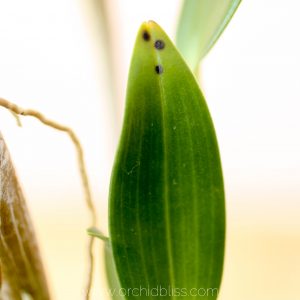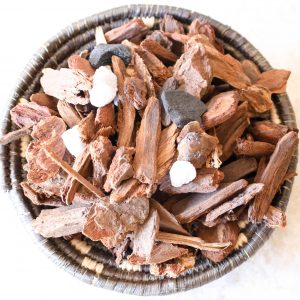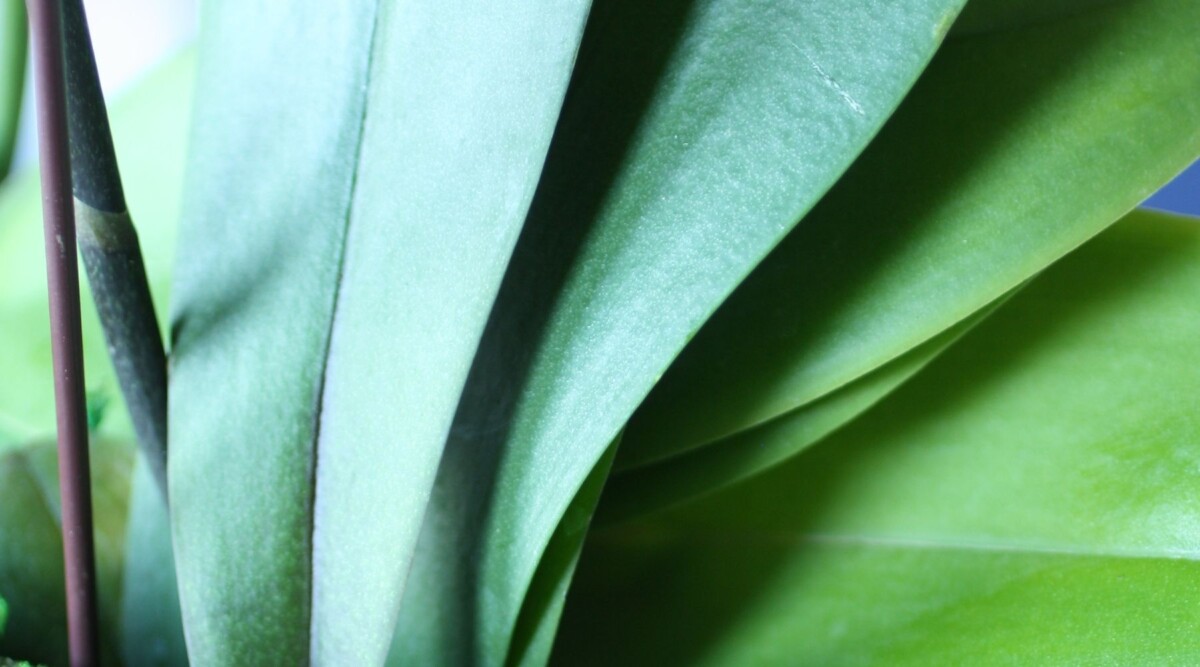
Trimming Orchid Leaves: The Complete Guide
While orchids benefit from post-bloom pruning as this will promote future flowering and improve the plant’s health, it is a treatment that is meant for dead stems and roots, not necessarily the leaves. Typically, pruning and trimming orchid leaves should be avoided; however, there are times when it may be an appropriate action.
Trimming orchid leaves may be required if the plant has a bacterial or fungal disease. Cut leaves with sterilized blades and treat the plant with a fungicide afterward to prevent further infection. Allow recovery in an environment with comfortable temperatures, low humidity, and good airflow.
Even the most vigilant orchid owner can have damage or disease strike these delicate plants as they are always under threat of injury. But not all problems require trimming off leaves. This article will help you decide when this task is necessary and, if it is needed, how to do it right.
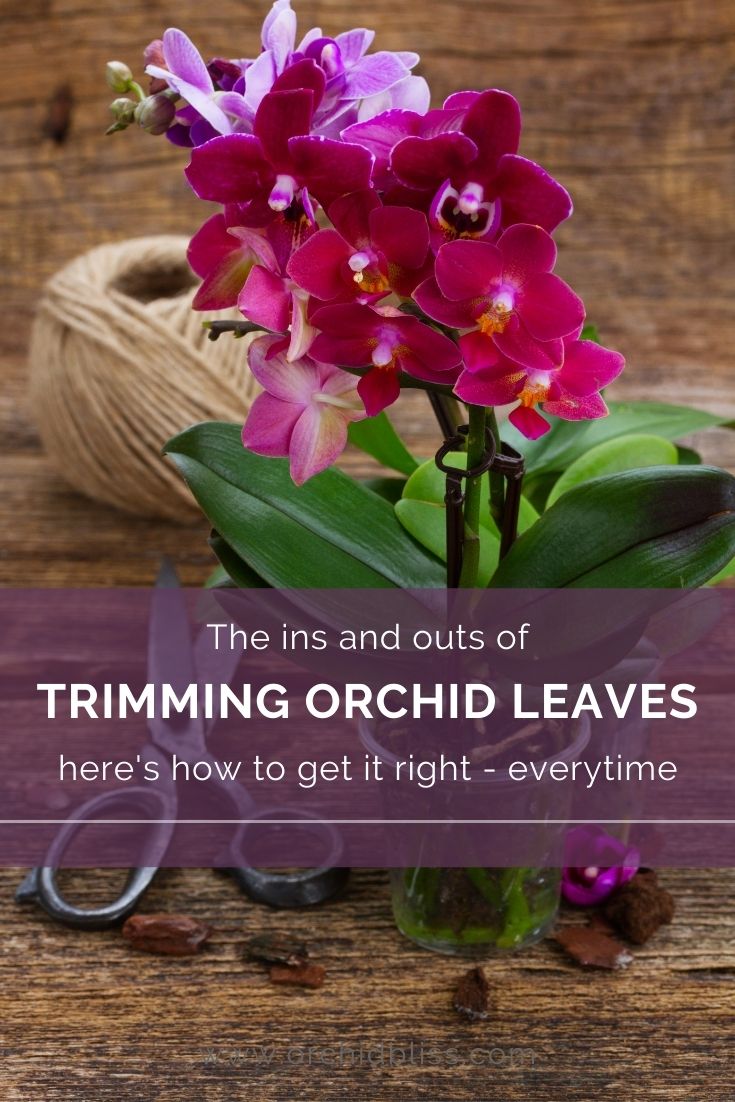
Some of the links on this page may be affiliate links. Click here to learn more.
Why You Should Trim Orchid Leaves
When it comes to pruning orchids in general, there’s one important thing to know: your orchid hates it. Trimming and pruning for aesthetic’s sake as though it were a bonsai is not the attention your orchid wants, nor is that what it deserves.
There may come a time when your orchid is affected by some damage or disease from which it cannot heal or fully recover and start to cause rotting in the affected areas. If that happens, there are many situations in which trimming the leaves could help the orchid to recover and strengthen–or at the very least, prevent the issue from spreading into otherwise healthy parts of the plant.
Keep in mind that one infected plant could infect the whole garden, so you can see how it is important to address any disease or damage you suspect may have occurred as soon as you notice evidence of such. You will often notice colored spots or withering in the leaves if a plant has a potentially deadly problem.
Orchids are vulnerable to damage and disease for many reasons, and once compromised, they risk death. So if your orchid develops symptoms indicating a serious issue is at hand, you may find yourself in need of trimming leaves, perhaps removing them altogether.
What Causes a Need to Trim Your Orchid’s Leaves?
Cold Damage
When growing outdoors, you can occasionally notice cold damage from unexpected temperature drops or as winter weather rolls in. A common spot for cold damage is on the leaves of the orchid. The best way to avoid this is by regularly checking the weather forecast to transfer the plant or otherwise protect it before this happens.
But even despite your best efforts, you may have your orchids fall victim to a freeze. Should this happen, frost crystals will have punctured through cell walls in the plant. This does not always mean death for the plant, although you most likely will have some damaged leaves. The places in which the leaves are affected will thin out and often collapse because the tissue is dead.
In general, there is no real solution or fix to cold damage. Instead, you have to live with it–and hope your orchid continues to live with it, as well. The only action you can take after cold damage has occurred would be to remove any portions of the dead tissue to prevent the dead tissue from decaying and infecting more of the plant.
Yellowing From Infection
There are several reasons the leaves of your orchid may turn yellow. Sometimes the problem can be corrected, and the plant will remain healthy, but there is nothing you can do but wait and see what happens. Orchid leaves may turn yellow because:
- The leaf is at the end of its life cycle
- Temperatures are too low
- They are receiving too much direct sunlight
- You are over-fertilizing
- You are not using the right fertilizer
- They are overwatered
- Root rot has developed
- There is a bacterial or fungal infection
Except for the last three things on that list, yellow leaves are not a cause for trimming or pruning. In those cases, cutting the plant raises the risk of getting an infection that could lead to further extraneous trimming or even death for your orchid, so it’s best to determine the base cause and adjust care accordingly.
However, if orchid leaves are turning yellow due to disease, then trimming off the affected portion of the leaf, or removing a leaf completely, might be what you need to do to protect and save the rest of the plant.
Bacterial and Fungal Diseases
Bacterial and fungal diseases can easily affect even the strongest, most enduring orchids. Unfortunately, the moist, humid environment in which orchids thrive is ideal for these infections to grow. And they can be fatal for your plant if it is infected for too long. If you suspect that your orchids are infected by bacterial or fungal diseases, promptly start a corrective treatment to give your plant a fighting chance to recover.
Different kinds of bacterial and fungal diseases will affect the plant differently and have different treatments for each, so diagnosing the actual problem in your plant is paramount. Some problems may affect the roots only; others will affect leaves and blooms as well. Only once you have identified the problem can you properly put together an action plan for plant recovery.
As it were, discolored leaves and foul odor are the two clear signs that your orchids have a bacterial infection. You will often see black or brown spots in the leaves or stems, and the offensive scent may be fairly intense.
Problems From Overwatering
It is common to see bacterial and fungal infections in orchids that are being overwatered, in orchids whose foliage is kept wet for too long, or when proper draining does not occur. Typically this will cause roots and leaves to start to rot. This can be avoided by increasing airflow movement around your orchid or by watering earlier in the morning, so your orchid has a chance to dry out.
Improper watering often causes a host of problems, resulting in an unhealthy orchid. To avoid these pitfalls, click here to grab your cheat sheet to learn how to grow healthier orchids. It will be super helpful.
Bacterial Soft and Brown Rot
A common orchid disease that begins on the orchid’s leaf, this rot starts as a soft, watery sore, and eventually, it turns brown. As the infection worsens, the brown spot will begin to discharge a dark, foul-smelling liquid. The infected area will spread quickly, and in just one to two days, the whole leaf will turn soft and slimy.
Fungal Crown Rot
This is the most common orchid fungal disease and the most dangerous as well. If left untreated, your orchid could die within a week after infection. The disease is first identified through a slight discoloration either at the leaf base or at the plant’s center. Orchids infected with this disease should have all infected portions pruned and removed. CLICK HERE, to learn how to identify, treat, and prevent crown rot.
Phyllosticta Capitalensis
At the onset of this fungal growth, leaf spots will typically be small, circular, and either yellow or black in color, and they may stay like that for several weeks or months. Eventually, however, the fungal growth will strengthen in the leaf tissue and kill the leaf in a week or two. This should be stopped by cutting off the infected portion of the leaf.
When Trimming Leaves Is NOT the Solution
When You Have a Pest Infestation
While several pests may try to attack your orchid (commonly scale, thrips, mites, and mealybugs), an infestation is never a reason to start pruning and cutting up your orchid. This is not a good defense–or offense, for that matter–when battling pest problems.
Small pest infestations can be treated with rubbing alcohol on some orchids. Simply soak a cotton swab and then rub or dab the pests off and away from the plant. Larger infestations may require “washing” the orchid in a pesticide solution. Orchids are incredibly sensitive, so you will want to use the least toxic options you can find.
Try things like neem oil, cinnamon, or eucalyptus oil for a natural, toxic-free insect repellent that is not only safe for your orchid but safe for the rest of the environment as well. Also, check orchids for pests often so you can combat small infestations before they become big infestations.
When Your Orchid Is Suffering From Fertilizer Burn
Using too much fertilizer can cause the tips of the leaves of your orchid to turn brown. This can become fatal to your orchid if left untreated. If it’s not a case of over-fertilizing, it is probably due to fertilizer salts having collected over time in your potting mix or substrate. In either case, the tell-tale sign you have a fertilizer-related problem will be brown-tipped leaves.
When it comes to fertilizing orchids, the rule of thumb is to do it “weakly, weekly.” So if fertilizer burn is your issue, you are fertilizing too often, or the concentration is too strong. Upon diagnosis, you may wish to consider re-potting or re-mounting after flushing out your orchid roots, as this is where the residual build-up collects.
It is not recommended to trim off brown tips caused by fertilizer burn. Depending on how severe the damage is, recovery is possible. Double-check your fertilizer instructions and adjust the solution if necessary, or change your fertilizing schedule to have more plain waterings in between each application. You may wish to consider re-potting or re-mounting after flushing out your orchid roots, as this is where the residual build-up collects.
When Your Orchid Is Sunburned
When orchids are overexposed to intense, direct sunlight, just like people, they can get sunburned. Sun damage generally begins as white blemishes with a ring of brown on the leaves. Shortly after that, the yellowing of the leaf will occur. Spots will then turn brown, purple, or black. Once this damage is done, it cannot be undone, although that doesn’t mean your orchid will not recover.
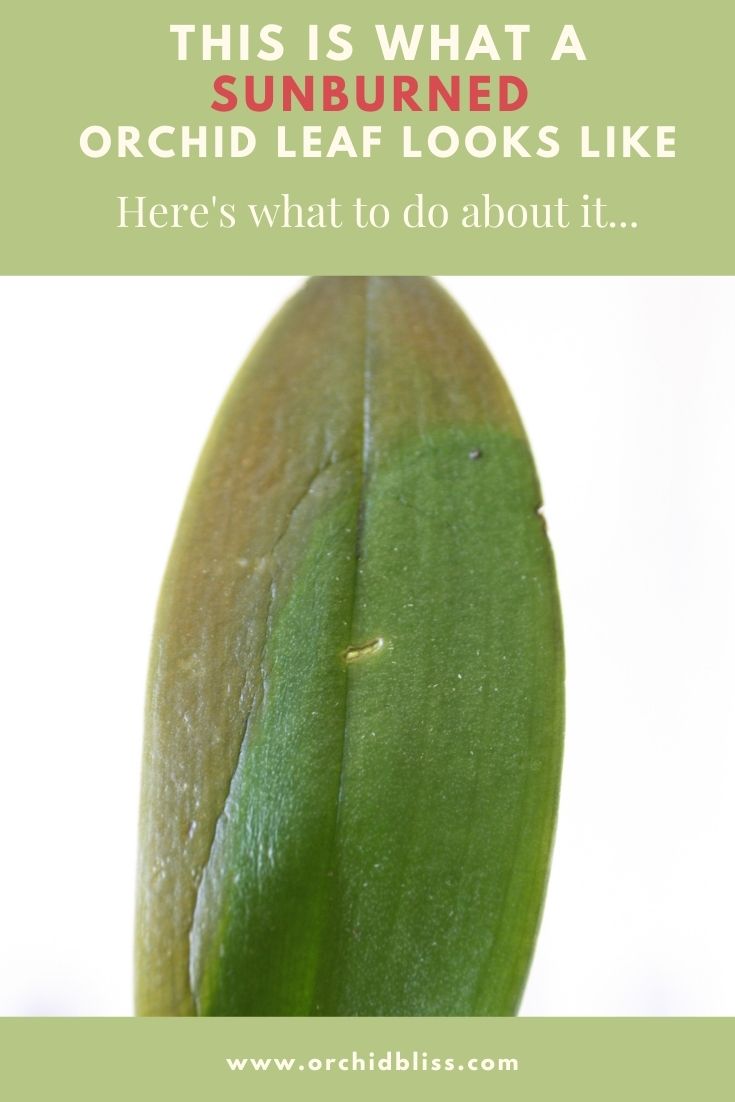
Orchids love sunlight; however, they do not enjoy direct sunlight. In nature, these flowers usually attach themselves partway up the tree so that there is foliage to cover them from receiving direct light. When growing indoors by a window, consider a sheer curtain to dampen the light.
When Yellowing Occurs in Leaves at the End of the Normal Life Cycle
Most orchids, although there are some exceptions, will normally have four leaves. As the plant grows, the leaves go through a natural life cycle like the rest of the orchid, and it is normal to see leaves turn yellow once the orchid is no longer caring for them.
The bottom leaves or back-bulbs that originate from older pseudobulbs will be the first to turn yellow. You can expect this from all leaves eventually, as one by one they eventually fall as new leaves emerge further up the stem.
While yellowing leaves may be a bit of an eye sore, it isn’t recommended that you trim them off your orchid and risk the chance of infection. Instead, you should wait for the leaf to fall from the stem on its own. However, if your plant is weakened or otherwise recovering from something, you may wish to cut off the leaf to help focus any extra energy the plant has on the bigger problem.
If a new leaf starts to yellow, then an issue such as improper lighting or disease will need to be investigated and addressed.
How to Trim Orchid Leaves in 5 Easy Steps
Gather Your Tools & Supplies
To trim your orchid leaves, first and foremost, you need a sharp cutting tool. Whatever you have available should suffice. Choose from:
- Scissors
- Pruning shears
- Kitchen knife
- X-Acto blade
- Razorblade
- Samurai sword
Granted, that last one isn’t the professionally recommended option, but you get the point. As long as it is sharp and you are comfortable using it, any tool will do. You will also need:
- Rubbing alcohol or another sterilizing agent
- Paper towels or a clean, sterile tea towel
- Antifungal treatment (cinnamon works well)
- Butane kitchen torch (this is my go-to method for sterilizing my shears)
Sterilize Your Cutting Tools
To prevent the spread of other bacteria and diseases, you will want to use clean, sterilized cutting tools to trim your orchid leaves. If you have more than one affected plant, you will want a separate blade/tool for each one–or you should clean and sterilize the blade after each use before tending to the next plant.
A mild bleach solution is acceptable for sterilizing. However, rubbing alcohol is just as acceptable and is what most hospitals use for sterilizing medical tools used on people, so it is safe for your orchid as well. You are welcome to boil your tools or use a flame, but metal tools may rust, and fire will blacken the tool with smoke. Rubbing alcohol is easy, fast, and effective.
Dip scissors or blades in a vessel of rubbing alcohol so that the tool can soak for at least thirty seconds. Shears/scissors will require you to open and close them while soaking so the alcohol can cover all the blade parts. Once enough time has passed, remove tools from rubbing alcohol and place them on paper towels or equivalent to dry. (Alcohol will dry very rapidly in just a few minutes.)
My favorite way to sterilize cutting tools is to use a kitchen torch. Simply pass the blades of the cutting shears through the flame for several seconds. It’s effective, easy to do, and there is no waste.
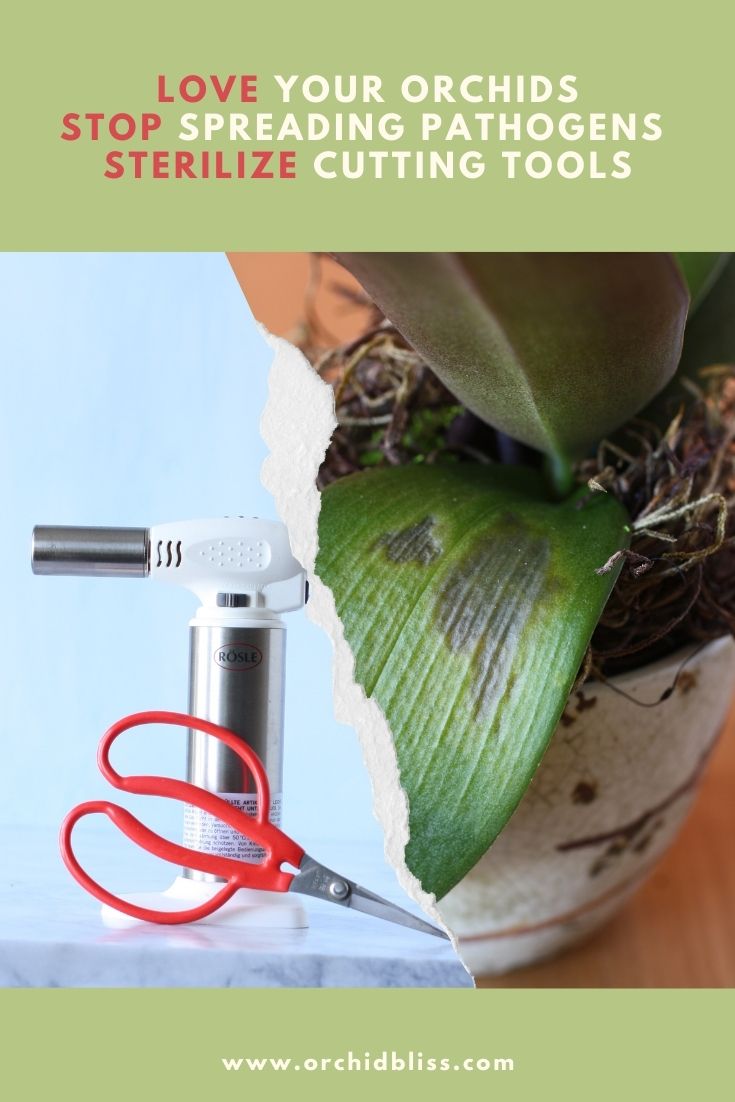
Trim Your Orchid Leaves
For leaves that are wilting or infected with a disease, make a judgment call on how much of the leaf needs to be trimmed. You may be able to eliminate the affected portion provided the problem is minimal and contained. However, if most of the leaf has been compromised, it is best to trim off the entire leaf from the orchid base.
If you are only trimming off the affected portion of the leaf/leaves, trim a little further past the infection to ensure you cut out any bacteria that may have started to spread and have yet to make a visible blight proving such. When removing the entire leaf, cut right at the base where the leaf meets the stem.
Have a plan of action, and then cut with purpose. Trimming or pruning any plant, even when necessary and beneficial to the plant, does hurt the plant and creates a mild state of shock from which it must recover. Making the least number of cuts possible will help make this a less traumatic experience for your orchid.
Apply Antifungal Treatment
Anywhere you cut the plant, you will want to treat that spot with an antifungal orchid treatment of some kind. Follow the package directions of your favorite brand, fungicide, or grab some cinnamon from the kitchen cupboard for a natural option. Even if you decide your orchid has a bacterial infection, a fungicide will bar against a subsequent infection.
If you are using cinnamon, be careful to avoid getting any on healthy leaves or parts that were not cut. The spice will pull moisture out of the leaf and can dehydrate your orchid.
Relocate Orchid for Recovery
After trimming your orchid leaves, relocate the plant to a space that has excellent air circulation, a lower humidity level, and temperatures that are between 65° and 80°F (18° and 27°C). This will lower the chance of the infection spreading and further affecting your orchid.
Additionally, if you normally utilize an overhead watering system for multiple orchids, discontinue use until your plants have fully recovered, as water will help spread bacteria. You will also need to keep water from getting onto the part of the leaf that was trimmed.
If you still are feeling uneasy about the process, the following video covers everything here with a nice visual:
Conclusion
Overall, trimming orchid leaves is not necessary for proper growth. Any cuts in the plant are open to infection and, therefore, should be avoided. However, if your orchid has been infected by fungal or bacterial diseases, trimming off affected leaves may help to save the plant. If you need to trim leaves on your orchid, be sure to follow this guide to lessen the risk of further complications in the plant and raise its chance of complete recovery.
Sources
- WikiHow: How to Prune Orchids: 14 Steps (With Pictures)
- Brilliant Orchids: How to Prune an Orchid – Step by Step Guide
- Just Add Ice Orchids: Orchid Care: When and How to Cut an Orchid Leaf
- Just Add Ice Orchids: How to Treat Orchid Bacterial, Fungal Diseases
- My Garden Guide: Pruning Orchids
- Orchid Fetish: Orchid Diseases, Bacteria Fungus Infections & Pest Treatments
- Orchid Care Zone: How to Treat Fungal and Bacterial Infections
- Just Add Ice Orchids: How to Treat Orchid Bacterial, Fungal Diseases
- Orchideria: Yellow Leaves on Your Orchid: 8 Causes and Their Remedies

